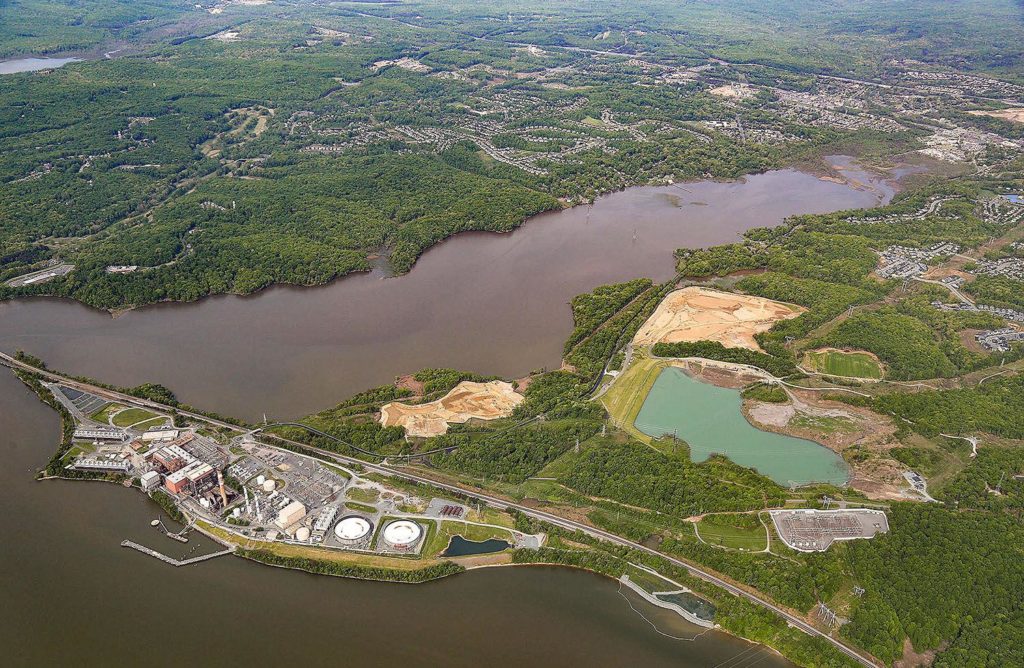By Whitney Pipkin, Bay Journal News Service
Dominion Energy wants to create a permanent solution for a decades-long pileup of coal ash by building a new, lined landfill on its Possum Point property by the Potomac River. The Virginia utility company presented its plans to a small group of stakeholders during an online meeting in January.
The Possum Point Power Station burned coal for power from 1948 to 2002, creating expansive ponds throughout the property to store the resulting ash. The site’s five ash ponds have over the last six years been consolidated into one that now holds 4 million cubic yards of coal ash—enough to fill the Capitol Rotunda 83 times.
Nationwide, coal ash sitting in ponds and pits has become a large industrial waste stream, leaving states and utilities grappling with strategies for safe disposal. The ash contains toxic chemicals and heavy metals such as arsenic, lead and mercury that pose health risks to people, fish and wildlife.
Virginia is among a handful of states with coal ash closure requirements that are stricter than the federal standards were at the time the state law was passed.
Spencer Adkins, director of power generation projects at Dominion, explained during the online meeting that the company’s preferred method for handling the ash at Possum Point is to create a new lined landfill next to the existing storage pond.
Doing so would cost $347 million, Dominion estimates. Recycling half of the ash to create building materials and removing the rest by truck would cost about twice as much. Recycling half and removing the rest by rail would cost about three times as much—as would removing all of the ash to an offsite lined landfill, the company says.
“In terms of impact, cost and permitting, we think this is a very attractive option. We think it is least impactful to the local neighborhood,” Adkins said.
Dominion originally planned to permanently “cap” the coal ash in its current location in the clay-lined pond. The company took a similar approach to legacy coal ash pits at three other power stations located along Chesapeake Bay rivers in Virginia.
But a 2019 state law required utilities to move piles of coal ash currently stored at a handful of power stations to landfills with modern synthetic liners, or to recycle them. The law also requires that about 25 percent of the ash from at least two of the four affected sites be recycled.
Some environmentalists who’ve followed Dominion’s coal ash decisions for years still oppose keeping the ash at Possum Point.
“My position is consistent,” Potomac Riverkeeper Dean Naujoks said. “We want all the ash moved from the banks of the Potomac River, and we want as much recycled as possible and [the rest] put in a lined landfill so it doesn’t threaten water quality. And we want it hauled out by rail. We haven’t changed our position.”
Those who prefer transporting the ash by rail say it would reduce the impact of truck traffic and emissions on the local community as well as the potential for coal ash spills on roads.
The landfill proposed for a northcentral section of the Possum Point property would also be close to a residential development called Potomac Shores, which has sprawled across the peninsula since coal ash discussions first started in 2016. Some homes that sold for more than $500,000 in 2020 would be about 700 feet from the proposed landfill.
“Does Prince William County support landfilling coal ash 700 feet from residential properties? I just can’t imagine,” Naujoks said.
Prince William County Supervisor Andrea Bailey told local media that she was “very disappointed” in Dominion’s plan to put the ash in an onsite landfill.
“I think Dominion is recommending this because it is the most inexpensive way to solve the problem,” Bailey told Inside Nova. “Inexpensive is not always the best when you’re talking about human lives.”
She also said at the close of Dominion’s presentation that she plans to assemble a local taskforce to discuss options with Dominion.
The utility will need to seek a permit from the county to construct a coal combustion residual (CCR) landfill for the ash, and the State Corporation Commission must approve its plans and any additional costs to ratepayers. The new landfill would also need air and wetlands permits from the state, Dominion said.
Dominion is working to dismantle longstanding coal ash piles and pits at three other power station near Bay rivers in Virginia. It plans to recycle half of the coal ash from ponds at Chesterfield Power Station on the James River and to move the other half to a nearby existing, lined landfill. Ash from Bremo Power Station, also near the James River, would be placed in a new, lined landfill. All of the ash from Chesapeake Energy Center on the Elizabeth River would be recycled.




